Target Information
| Target General Information | Top | |||||
|---|---|---|---|---|---|---|
| Target ID |
T08391
(Former ID: TTDC00187)
|
|||||
| Target Name |
Janus kinase 2 (JAK-2)
|
|||||
| Synonyms |
Tyrosine-protein kinase JAK2
Click to Show/Hide
|
|||||
| Gene Name |
JAK2
|
|||||
| Target Type |
Successful target
|
[1] | ||||
| Disease | [+] 4 Target-related Diseases | + | ||||
| 1 | Atopic eczema [ICD-11: EA80] | |||||
| 2 | Myeloproliferative neoplasm [ICD-11: 2A20] | |||||
| 3 | Rheumatoid arthritis [ICD-11: FA20] | |||||
| 4 | Thrombocytosis [ICD-11: 3B63] | |||||
| Function |
Mediates essential signaling events in both innate and adaptive immunity. In the cytoplasm, plays a pivotal role in signal transduction via its association with type I receptors such as growth hormone (GHR), prolactin (PRLR), leptin (LEPR), erythropoietin (EPOR), thrombopoietin (THPO); or type II receptors including IFN-alpha, IFN-beta, IFN-gamma and multiple interleukins. Following ligand-binding to cell surface receptors, phosphorylates specific tyrosine residues on the cytoplasmic tails of the receptor, creating docking sites for STATs proteins. Subsequently, phosphorylates the STATs proteins once they are recruited to the receptor. Phosphorylated STATs then form homodimer or heterodimers and translocate to the nucleus to activate gene transcription. For example, cell stimulation with erythropoietin (EPO) during erythropoiesis leads to JAK2 autophosphorylation, activation, and its association with erythropoietin receptor (EPOR) that becomes phosphorylated in its cytoplasmic domain. Then, STAT5 (STAT5A or STAT5B) is recruited, phosphorylated and activated by JAK2. Once activated, dimerized STAT5 translocates into the nucleus and promotes the transcription of several essential genes involved in the modulation of erythropoiesis. Part of a signaling cascade that is activated by increased cellular retinol and that leads to the activation of STAT5 (STAT5A or STAT5B). In addition, JAK2 mediates angiotensin-2-induced ARHGEF1 phosphorylation. Plays a role in cell cycle by phosphorylating CDKN1B. Cooperates with TEC through reciprocal phosphorylation to mediate cytokine-driven activation of FOS transcription. In the nucleus, plays a key role in chromatin by specifically mediating phosphorylation of 'Tyr-41' of histone H3 (H3Y41ph), a specific tag that promotes exclusion of CBX5 (HP1 alpha) from chromatin. Non-receptor tyrosine kinase involved in various processes such as cell growth, development, differentiation or histone modifications.
Click to Show/Hide
|
|||||
| BioChemical Class |
Kinase
|
|||||
| UniProt ID | ||||||
| EC Number |
EC 2.7.10.2
|
|||||
| Sequence |
MGMACLTMTEMEGTSTSSIYQNGDISGNANSMKQIDPVLQVYLYHSLGKSEADYLTFPSG
EYVAEEICIAASKACGITPVYHNMFALMSETERIWYPPNHVFHIDESTRHNVLYRIRFYF PRWYCSGSNRAYRHGISRGAEAPLLDDFVMSYLFAQWRHDFVHGWIKVPVTHETQEECLG MAVLDMMRIAKENDQTPLAIYNSISYKTFLPKCIRAKIQDYHILTRKRIRYRFRRFIQQF SQCKATARNLKLKYLINLETLQSAFYTEKFEVKEPGSGPSGEEIFATIIITGNGGIQWSR GKHKESETLTEQDLQLYCDFPNIIDVSIKQANQEGSNESRVVTIHKQDGKNLEIELSSLR EALSFVSLIDGYYRLTADAHHYLCKEVAPPAVLENIQSNCHGPISMDFAISKLKKAGNQT GLYVLRCSPKDFNKYFLTFAVERENVIEYKHCLITKNENEEYNLSGTKKNFSSLKDLLNC YQMETVRSDNIIFQFTKCCPPKPKDKSNLLVFRTNGVSDVPTSPTLQRPTHMNQMVFHKI RNEDLIFNESLGQGTFTKIFKGVRREVGDYGQLHETEVLLKVLDKAHRNYSESFFEAASM MSKLSHKHLVLNYGVCVCGDENILVQEFVKFGSLDTYLKKNKNCINILWKLEVAKQLAWA MHFLEENTLIHGNVCAKNILLIREEDRKTGNPPFIKLSDPGISITVLPKDILQERIPWVP PECIENPKNLNLATDKWSFGTTLWEICSGGDKPLSALDSQRKLQFYEDRHQLPAPKWAEL ANLINNCMDYEPDFRPSFRAIIRDLNSLFTPDYELLTENDMLPNMRIGALGFSGAFEDRD PTQFEERHLKFLQQLGKGNFGSVEMCRYDPLQDNTGEVVAVKKLQHSTEEHLRDFEREIE ILKSLQHDNIVKYKGVCYSAGRRNLKLIMEYLPYGSLRDYLQKHKERIDHIKLLQYTSQI CKGMEYLGTKRYIHRDLATRNILVENENRVKIGDFGLTKVLPQDKEYYKVKEPGESPIFW YAPESLTESKFSVASDVWSFGVVLYELFTYIEKSKSPPAEFMRMIGNDKQGQMIVFHLIE LLKNNGRLPRPDGCPDEIYMIMTECWNNNVNQRPSFRDLALRVDQIRDNMAG Click to Show/Hide
|
|||||
| 3D Structure | Click to Show 3D Structure of This Target | AlphaFold | ||||
| ADReCS ID | BADD_A03237 | |||||
| HIT2.0 ID | T65S3S | |||||
| Drugs and Modes of Action | Top | |||||
|---|---|---|---|---|---|---|
| Approved Drug(s) | [+] 3 Approved Drugs | + | ||||
| 1 | Abrocitinib | Drug Info | Approved | Atopic dermatitis | [7] | |
| 2 | Fedratinib | Drug Info | Approved | Myelofibrosis | [8] | |
| 3 | Momelotinib | Drug Info | Approved | Myelofibrosis | [9] | |
| Clinical Trial Drug(s) | [+] 12 Clinical Trial Drugs | + | ||||
| 1 | ITF2357 | Drug Info | Phase 3 | Duchenne dystrophy | [10] | |
| 2 | XL019 | Drug Info | Phase 3 | Solid tumour/cancer | [11], [12] | |
| 3 | AZD1480 | Drug Info | Phase 2 | Myeloproliferative syndrome | [16], [17] | |
| 4 | BMS-911543 | Drug Info | Phase 2 | Myelofibrosis | [18], [19] | |
| 5 | Cerdulatinib | Drug Info | Phase 2 | B-cell lymphoma | [20] | |
| 6 | CTP-543 | Drug Info | Phase 2 | Asthma | [21], [22] | |
| 7 | INCB039110 | Drug Info | Phase 2 | Malignant neoplasm | [23] | |
| 8 | LY2784544 | Drug Info | Phase 2 | Breast cancer | [24], [25], [26] | |
| 9 | NS-018 | Drug Info | Phase 1/2 | Myelofibrosis | [28], [29], [20] | |
| 10 | AC430 | Drug Info | Phase 1 | leukaemia | [34] | |
| 11 | Peginterferon beta | Drug Info | Phase 1 | Multiple sclerosis | [35] | |
| 12 | SB-1578 | Drug Info | Phase 1 | Solid tumour/cancer | [36] | |
| Discontinued Drug(s) | [+] 1 Discontinued Drugs | + | ||||
| 1 | AG490 | Drug Info | Terminated | Multiple myeloma | [37], [38] | |
| Mode of Action | [+] 2 Modes of Action | + | ||||
| Inhibitor | [+] 83 Inhibitor drugs | + | ||||
| 1 | Abrocitinib | Drug Info | [7] | |||
| 2 | Fedratinib | Drug Info | [8] | |||
| 3 | ITF2357 | Drug Info | [39], [40] | |||
| 4 | XL019 | Drug Info | [39] | |||
| 5 | CTP-543 | Drug Info | [21] | |||
| 6 | INCB039110 | Drug Info | [43] | |||
| 7 | Peginterferon beta | Drug Info | [46] | |||
| 8 | SB-1578 | Drug Info | [45], [47] | |||
| 9 | 1,2,4-triazolo[1,5a]pyridine derivative 1 | Drug Info | [48] | |||
| 10 | 1,2,4-triazolo[1,5a]pyridine derivative 2 | Drug Info | [48] | |||
| 11 | Alkynyl-substituted pyrimidinyl-pyrrole derivative 1 | Drug Info | [49] | |||
| 12 | Aminooxazole carboxamide derivative 1 | Drug Info | [49] | |||
| 13 | Aminotriazolopyridine derivative 1 | Drug Info | [48] | |||
| 14 | Aromatic bicyclic compound 1 | Drug Info | [50] | |||
| 15 | Aromatic bicyclic compound 3 | Drug Info | [50] | |||
| 16 | Aromatic bicyclic compound 4 | Drug Info | [50] | |||
| 17 | Aromatic bicyclic compound 5 | Drug Info | [50] | |||
| 18 | Aromatic bicyclic compound 6 | Drug Info | [50] | |||
| 19 | Benzimidazole derivative 7 | Drug Info | [48] | |||
| 20 | Bis-aminopyrimidine derivative 1 | Drug Info | [48] | |||
| 21 | Bis-aminopyrimidine derivative 2 | Drug Info | [48] | |||
| 22 | Bis-aminopyrimidine derivative 3 | Drug Info | [48] | |||
| 23 | Bis-aminopyrimidine derivative 4 | Drug Info | [48] | |||
| 24 | Bis-aminopyrimidine derivative 5 | Drug Info | [48] | |||
| 25 | Curcumin analog 2 | Drug Info | [50] | |||
| 26 | Cyanomethyl pypazole carboxamide derivative 1 | Drug Info | [49] | |||
| 27 | Cyclic cyanoethypypazole derivative 1 | Drug Info | [49] | |||
| 28 | Cycloalkyl nitrile pyrazolo pyridone derivative 1 | Drug Info | [49] | |||
| 29 | Cycloalkyl nitrile pyrazolo pyridone derivative 2 | Drug Info | [49] | |||
| 30 | Five-and-six-membered heterocyclic compound 1 | Drug Info | [49] | |||
| 31 | Geminally-substituted cyanoethylpypazolo pyridone derivative 1 | Drug Info | [49] | |||
| 32 | Geminally-substituted cyanoethylpypazolo pyridone derivative 2 | Drug Info | [49] | |||
| 33 | Isoxazole derivative 1 | Drug Info | [49] | |||
| 34 | Isoxazole derivative 2 | Drug Info | [49] | |||
| 35 | PMID27774822-Compound-Figure10Compound12 | Drug Info | [49] | |||
| 36 | PMID27774822-Compound-Figure10Compound4 | Drug Info | [49] | |||
| 37 | PMID27774822-Compound-Figure10Example1 | Drug Info | [49] | |||
| 38 | PMID27774822-Compound-Figure11Example5 | Drug Info | [49] | |||
| 39 | PMID27774822-Compound-Figure1Example20 | Drug Info | [49] | |||
| 40 | PMID27774822-Compound-Figure2Example1-1left | Drug Info | [49] | |||
| 41 | PMID27774822-Compound-Figure2Example1-1right | Drug Info | [49] | |||
| 42 | PMID27774822-Compound-Figure3CompoundI-165 | Drug Info | [49] | |||
| 43 | PMID27774822-Compound-Figure7Example63 | Drug Info | [49] | |||
| 44 | PMID27774822-Compound-Figure8Example5 | Drug Info | [49] | |||
| 45 | PMID27774824-Compound-Figure2Example4 | Drug Info | [48] | |||
| 46 | PMID27774824-Compound-Figure3Example18 | Drug Info | [48] | |||
| 47 | PMID27774824-Compound-Figure6Example12 | Drug Info | [48] | |||
| 48 | PMID27774824-Compound-Figure6Example6 | Drug Info | [48] | |||
| 49 | PMID27774824-Compound-Figure7Example10 | Drug Info | [48] | |||
| 50 | PMID27774824-Compound-Figure8Example22 | Drug Info | [48] | |||
| 51 | PMID27774824-Compound-Figure8Example99 | Drug Info | [48] | |||
| 52 | PMID27774824-Compound-Figure9Example2down | Drug Info | [48] | |||
| 53 | Pyrazolopyridine derivative 3 | Drug Info | [49] | |||
| 54 | Pyrazolopyridine derivative 4 | Drug Info | [49] | |||
| 55 | Pyrazolopyridine derivative 6 | Drug Info | [48] | |||
| 56 | Pyrazolopyridine derivative 7 | Drug Info | [48] | |||
| 57 | Pyrazolo[4,3-c]pyridine derivative 2 | Drug Info | [48] | |||
| 58 | Pyrimidopyridazinone derivative 1 | Drug Info | [48] | |||
| 59 | Pyrrole six-membered heteroaryl ring derivative 1 | Drug Info | [49] | |||
| 60 | Pyrrolo-pyridone derivative 1 | Drug Info | [49] | |||
| 61 | Pyrrolo-pyridone derivative 2 | Drug Info | [49] | |||
| 62 | Pyrrolo[2,3-d]pyrimidine derivative 6 | Drug Info | [49] | |||
| 63 | Pyrrolo[2,3-d]pyrimidine derivative 8 | Drug Info | [49] | |||
| 64 | Ruxolitinib derivative 2 | Drug Info | [48] | |||
| 65 | Triazolo-pyridine derivative 1 | Drug Info | [49] | |||
| 66 | Tricyclic compound 1 | Drug Info | [48] | |||
| 67 | Tricyclic compound 11 | Drug Info | [49] | |||
| 68 | Tricyclic heterocycle derivative 2 | Drug Info | [48] | |||
| 69 | Tricyclic heterocycle derivative 5 | Drug Info | [49] | |||
| 70 | Tricyclic pyrrolopyridine compound 1 | Drug Info | [49] | |||
| 71 | AG490 | Drug Info | [51], [52] | |||
| 72 | 5-phenyl-1H-indazol-3-amine | Drug Info | [53] | |||
| 73 | AMG-JAK2-01 | Drug Info | [43] | |||
| 74 | Atropisomer 1 | Drug Info | [54] | |||
| 75 | AZ960 | Drug Info | [55] | |||
| 76 | BVB-808 | Drug Info | [43] | |||
| 77 | CMP-6 | Drug Info | [56] | |||
| 78 | K-454 | Drug Info | [43] | |||
| 79 | NSC-1771 | Drug Info | [57] | |||
| 80 | ON-044580 | Drug Info | [58] | |||
| 81 | PMID21493067C1d | Drug Info | [59] | |||
| 82 | SGI-1252 | Drug Info | [43] | |||
| 83 | WHI-P154 | Drug Info | [60] | |||
| Modulator | [+] 7 Modulator drugs | + | ||||
| 1 | Momelotinib | Drug Info | [9] | |||
| 2 | AZD1480 | Drug Info | [41] | |||
| 3 | BMS-911543 | Drug Info | [19] | |||
| 4 | Cerdulatinib | Drug Info | [42] | |||
| 5 | LY2784544 | Drug Info | [44] | |||
| 6 | NS-018 | Drug Info | [29] | |||
| 7 | AC430 | Drug Info | [45] | |||
| Cell-based Target Expression Variations | Top | |||||
|---|---|---|---|---|---|---|
| Cell-based Target Expression Variations | ||||||
| Drug Binding Sites of Target | Top | |||||
|---|---|---|---|---|---|---|
| Ligand Name: Baricitinib | Ligand Info | |||||
| Structure Description | Human JAK2 JH1 domain in complex with Baricitinib | PDB:6WTO | ||||
| Method | X-ray diffraction | Resolution | 1.74 Å | Mutation | No | [61] |
| PDB Sequence |
QFEERHLKFL
852 QQLGKGNFGS862 VEMCRYDPLT875 GEVVAVKKLQ885 HSTEEHLRDF895 EREIEILKSL 905 QHDNIVKYKG915 VCYLKLIMEY931 LPYGSLRDYL941 QKHKERIDHI951 KLLQYTSQIC 961 KGMEYLGTKR971 YIHRDLATRN981 ILVENENRVK991 IGDFGLTKVL1001 PQDKEKVKSP 1017 IFWYAPESLT1027 ESKFSVASDV1037 WSFGVVLYEL1047 FTYIEKSKSP1057 PAEFMRMIGN 1067 DKQGQMIVFH1077 LIELLKNNGR1087 LPRPDGCPDE1097 IYMIMTECWN1107 NNVNQRPSFR 1117 DLALRVDQIR1127 DNMAGGS
|
|||||
|
|
LEU855
3.650
GLY856
3.215
LYS857
3.739
GLY858
4.191
GLY861
3.590
SER862
3.787
VAL863
2.959
ALA880
3.298
LYS882
3.974
VAL911
3.853
MET929
3.438
|
|||||
| Click to View More Binding Site Information of This Target and Ligand Pair | ||||||
| Ligand Name: Ruxolitinib | Ligand Info | |||||
| Structure Description | Human JAK2 JH1 domain in complex with Ruxolitinib | PDB:6WTN | ||||
| Method | X-ray diffraction | Resolution | 1.83 Å | Mutation | No | [61] |
| PDB Sequence |
QFEERHLKFL
852 QQLGKGNFGS862 VEMCRYDPLQ872 DNTGEVVAVK882 KLQHSTEEHL892 RDFEREIEIL 902 KSLQHDNIVK912 YKGVCYSRRN924 LKLIMEYLPY934 GSLRDYLQKH944 KERIDHIKLL 954 QYTSQICKGM964 EYLGTKRYIH974 RDLATRNILV984 ENENRVKIGD994 FGLTKVLPQD 1004 KEKVESPIFW1020 YAPESLTESK1030 FSVASDVWSF1040 GVVLYELFTY1050 IEKSKSPPAE 1060 FMRMIGNDKQ1070 GQMIVFHLIE1080 LLKNNGRLPR1090 PDGCPDEIYM1100 IMTECWNNNV 1110 NQRPSFRDLA1120 LRVDQIRDNM1130 AGGSG
|
|||||
|
|
LEU855
3.711
GLY856
3.611
LYS857
3.887
GLY858
3.775
GLY861
3.851
SER862
4.334
VAL863
3.768
ALA880
3.178
LYS882
4.224
VAL911
3.695
MET929
3.571
|
|||||
| Click to View More Binding Site Information of This Target and Ligand Pair | ||||||
| Click to View More Binding Site Information of This Target with Different Ligands | ||||||
| Different Human System Profiles of Target | Top |
|---|---|
|
Human Similarity Proteins
of target is determined by comparing the sequence similarity of all human proteins with the target based on BLAST. The similarity proteins for a target are defined as the proteins with E-value < 0.005 and outside the protein families of the target.
A target that has fewer human similarity proteins outside its family is commonly regarded to possess a greater capacity to avoid undesired interactions and thus increase the possibility of finding successful drugs
(Brief Bioinform, 21: 649-662, 2020).
Human Tissue Distribution
of target is determined from a proteomics study that quantified more than 12,000 genes across 32 normal human tissues. Tissue Specificity (TS) score was used to define the enrichment of target across tissues.
The distribution of targets among different tissues or organs need to be taken into consideration when assessing the target druggability, as it is generally accepted that the wider the target distribution, the greater the concern over potential adverse effects
(Nat Rev Drug Discov, 20: 64-81, 2021).
Human Pathway Affiliation
of target is determined by the life-essential pathways provided on KEGG database. The target-affiliated pathways were defined based on the following two criteria (a) the pathways of the studied target should be life-essential for both healthy individuals and patients, and (b) the studied target should occupy an upstream position in the pathways and therefore had the ability to regulate biological function.
Targets involved in a fewer pathways have greater likelihood to be successfully developed, while those associated with more human pathways increase the chance of undesirable interferences with other human processes
(Pharmacol Rev, 58: 259-279, 2006).
Biological Network Descriptors
of target is determined based on a human protein-protein interactions (PPI) network consisting of 9,309 proteins and 52,713 PPIs, which were with a high confidence score of ≥ 0.95 collected from STRING database.
The network properties of targets based on protein-protein interactions (PPIs) have been widely adopted for the assessment of target’s druggability. Proteins with high node degree tend to have a high impact on network function through multiple interactions, while proteins with high betweenness centrality are regarded to be central for communication in interaction networks and regulate the flow of signaling information
(Front Pharmacol, 9, 1245, 2018;
Curr Opin Struct Biol. 44:134-142, 2017).
Human Similarity Proteins
Human Tissue Distribution
Human Pathway Affiliation
Biological Network Descriptors
|
|
|
Note:
If a protein has TS (tissue specficity) scores at least in one tissue >= 2.5, this protein is called tissue-enriched (including tissue-enriched-but-not-specific and tissue-specific). In the plots, the vertical lines are at thresholds 2.5 and 4.
|
| KEGG Pathway | Pathway ID | Affiliated Target | Pathway Map |
|---|---|---|---|
| Chemokine signaling pathway | hsa04062 | Affiliated Target |
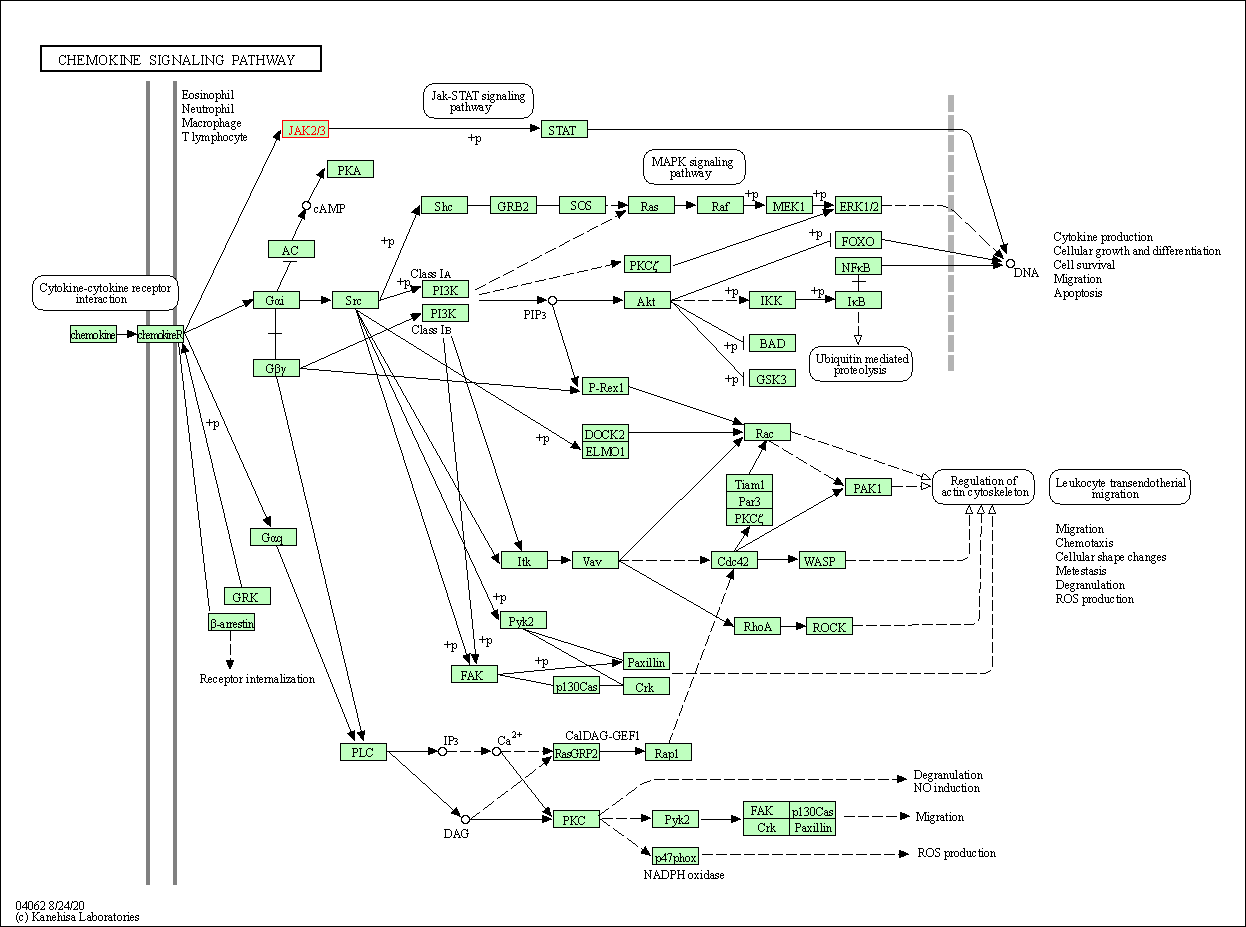
|
| Class: Organismal Systems => Immune system | Pathway Hierarchy | ||
| PI3K-Akt signaling pathway | hsa04151 | Affiliated Target |
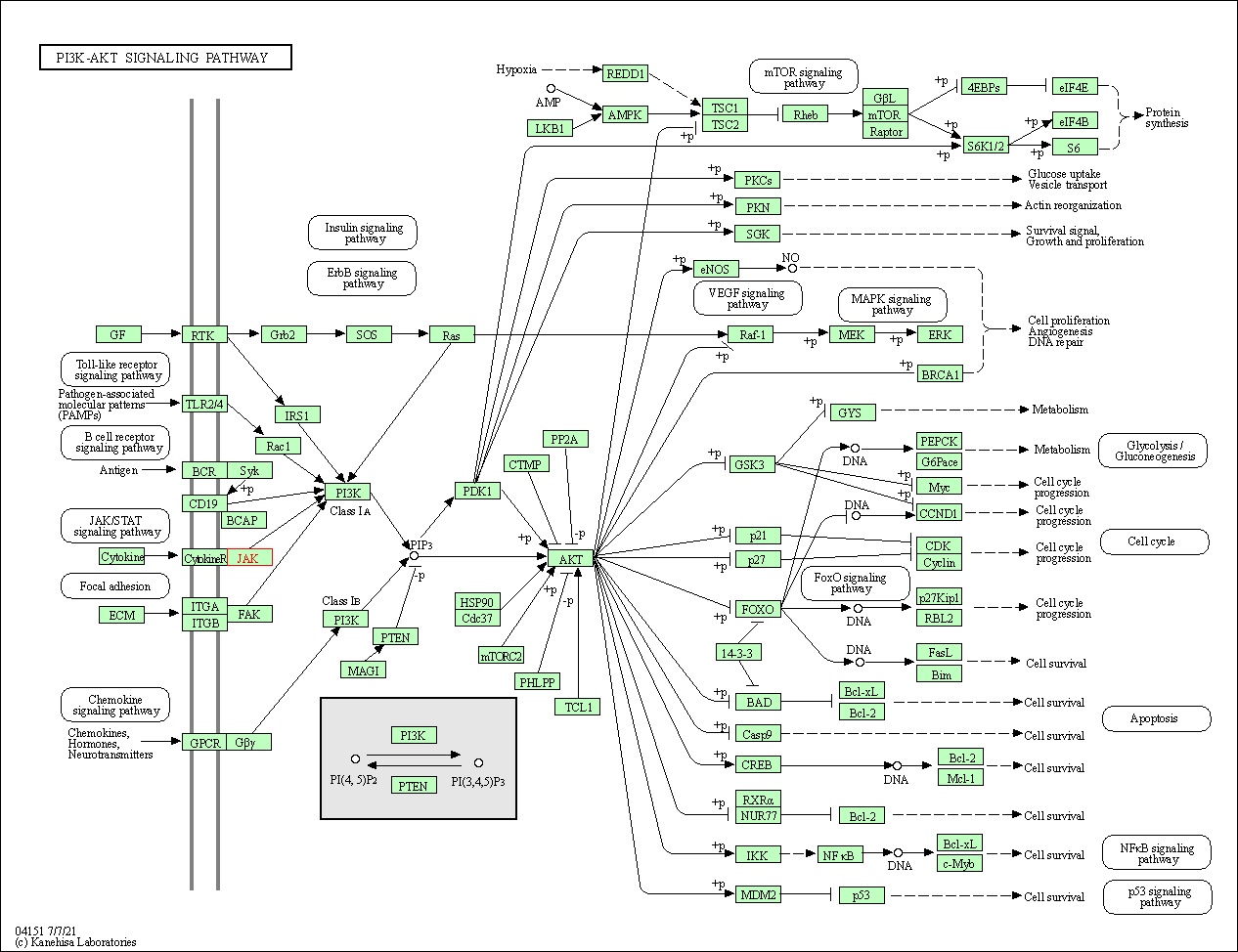
|
| Class: Environmental Information Processing => Signal transduction | Pathway Hierarchy | ||
| Necroptosis | hsa04217 | Affiliated Target |
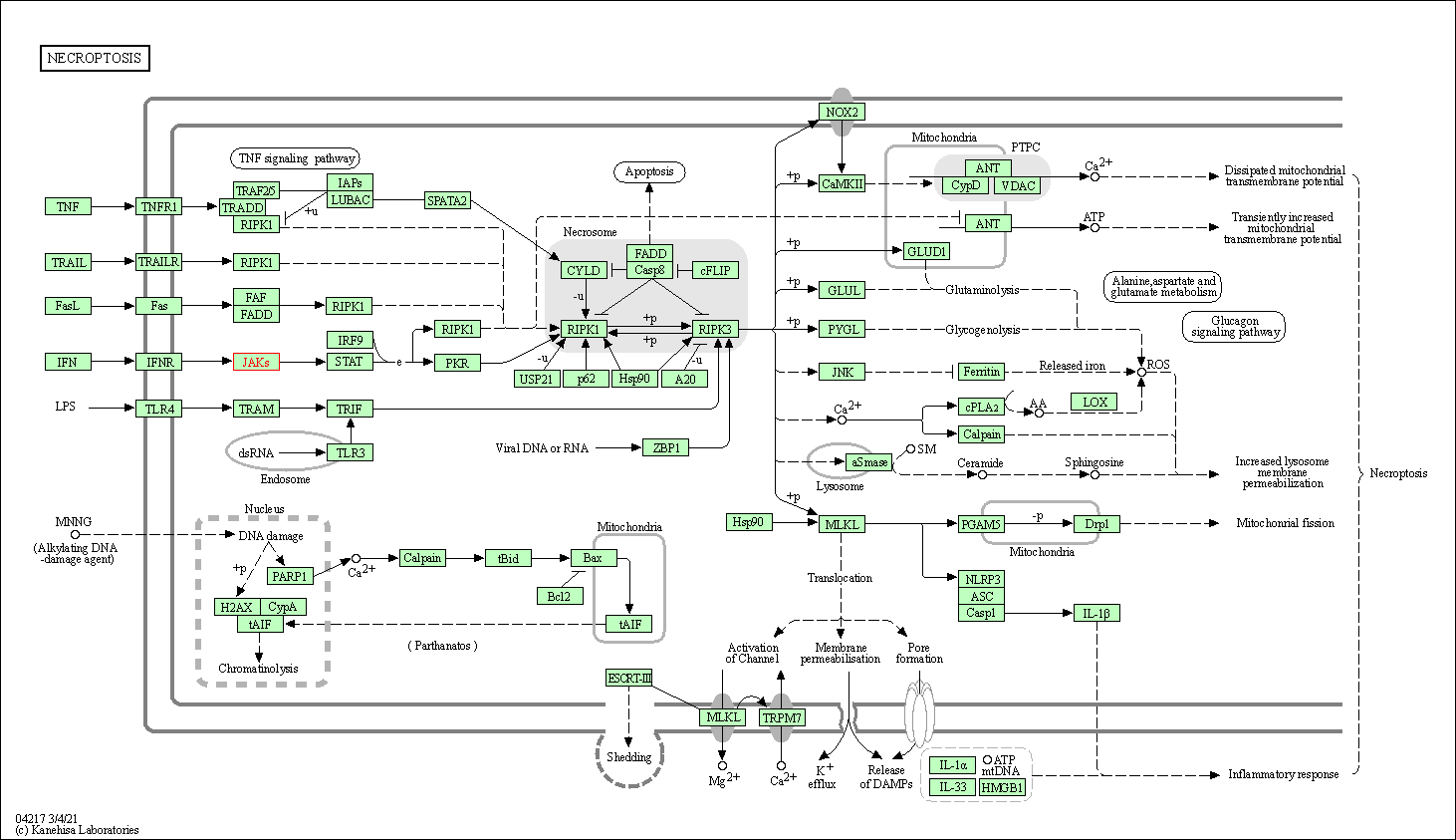
|
| Class: Cellular Processes => Cell growth and death | Pathway Hierarchy | ||
| Signaling pathways regulating pluripotency of stem cells | hsa04550 | Affiliated Target |
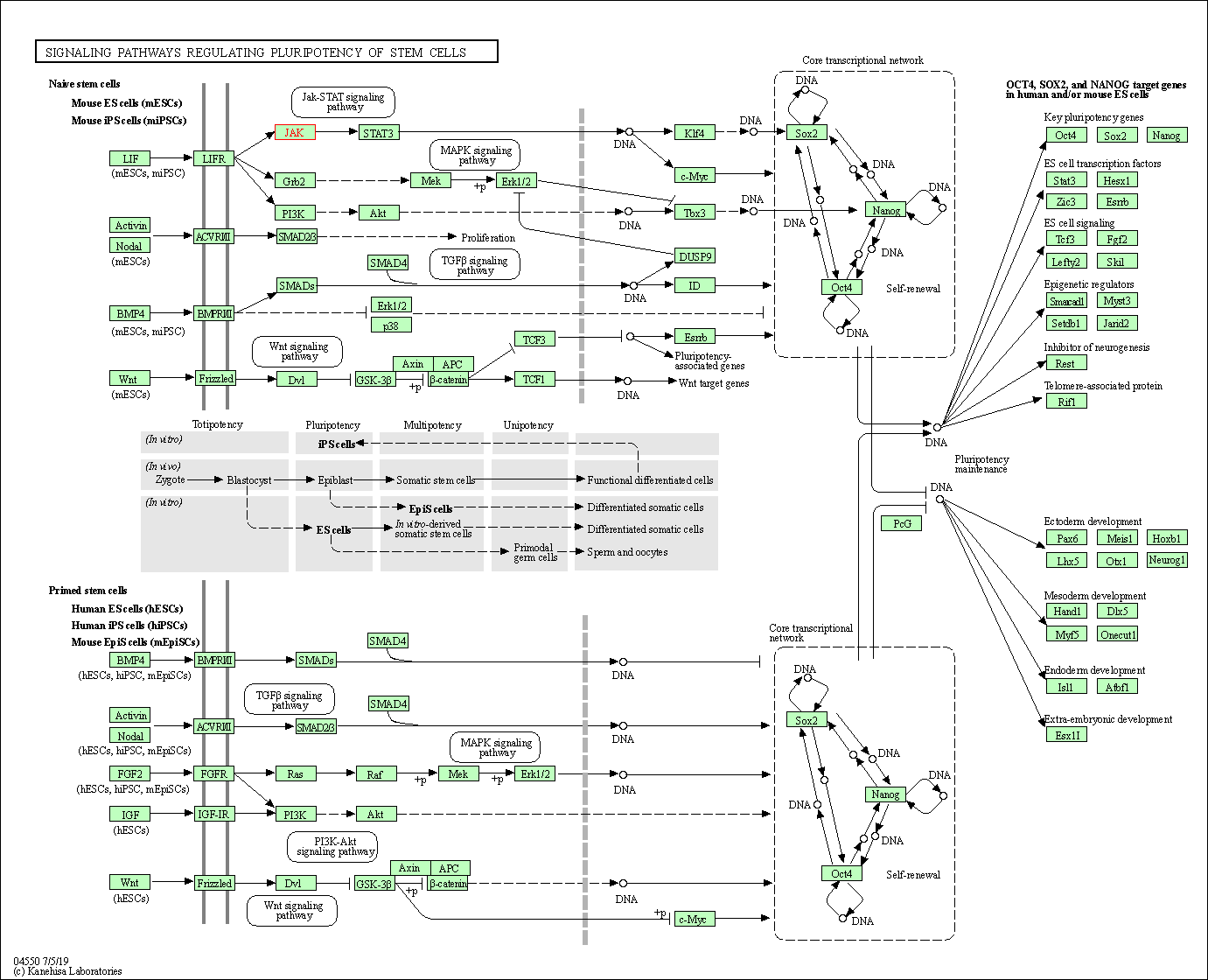
|
| Class: Cellular Processes => Cellular community - eukaryotes | Pathway Hierarchy | ||
| JAK-STAT signaling pathway | hsa04630 | Affiliated Target |
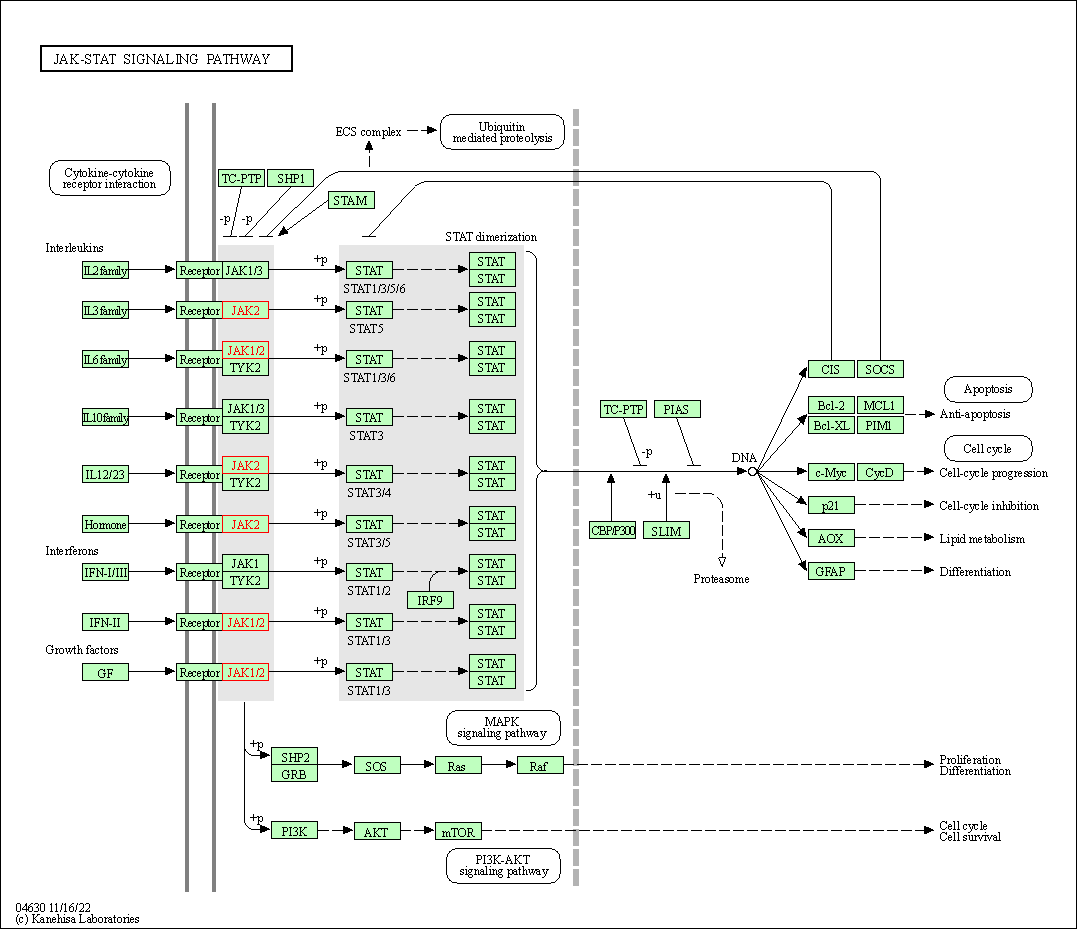
|
| Class: Environmental Information Processing => Signal transduction | Pathway Hierarchy | ||
| Th1 and Th2 cell differentiation | hsa04658 | Affiliated Target |

|
| Class: Organismal Systems => Immune system | Pathway Hierarchy | ||
| Th17 cell differentiation | hsa04659 | Affiliated Target |

|
| Class: Organismal Systems => Immune system | Pathway Hierarchy | ||
| Cholinergic synapse | hsa04725 | Affiliated Target |
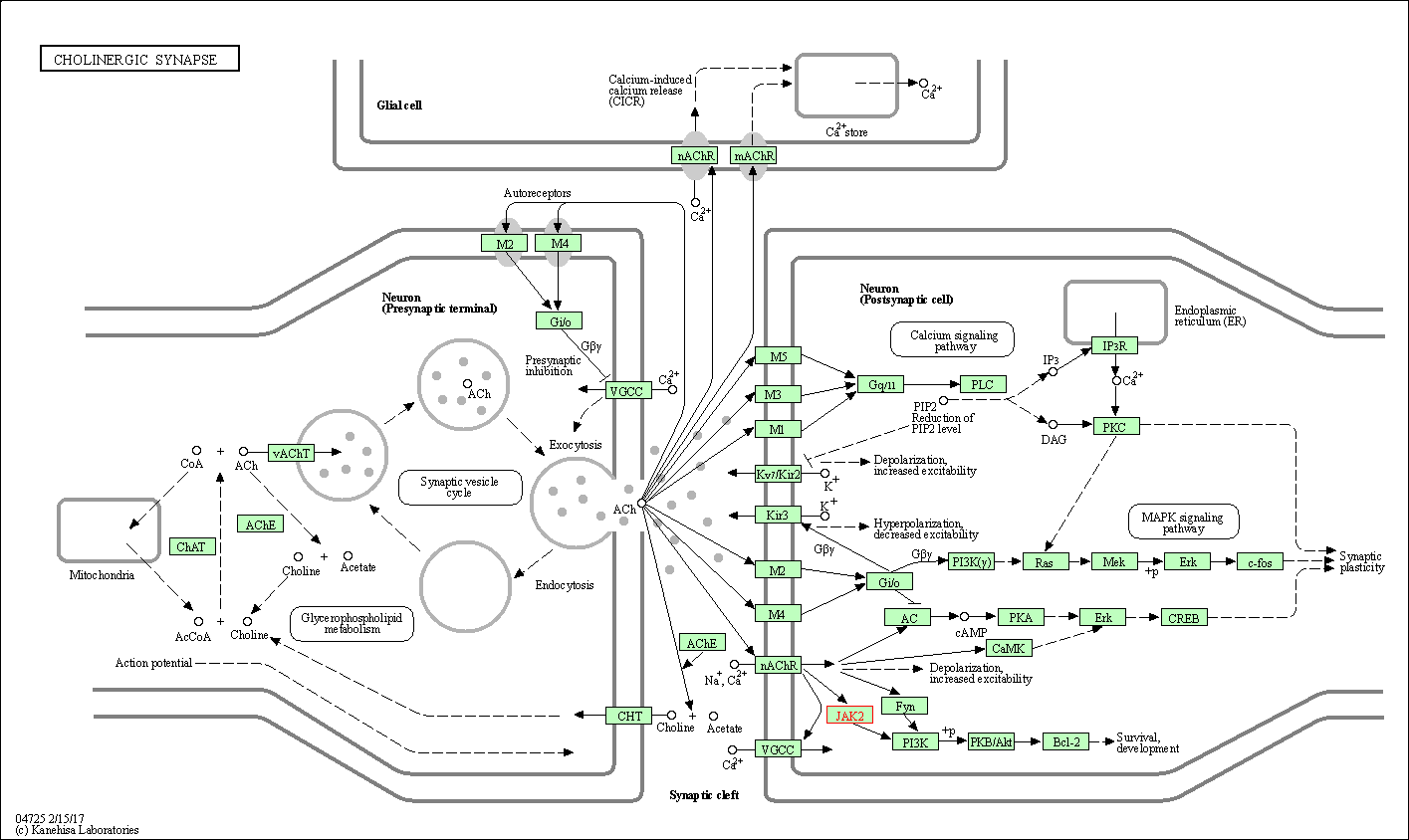
|
| Class: Organismal Systems => Nervous system | Pathway Hierarchy | ||
| Prolactin signaling pathway | hsa04917 | Affiliated Target |
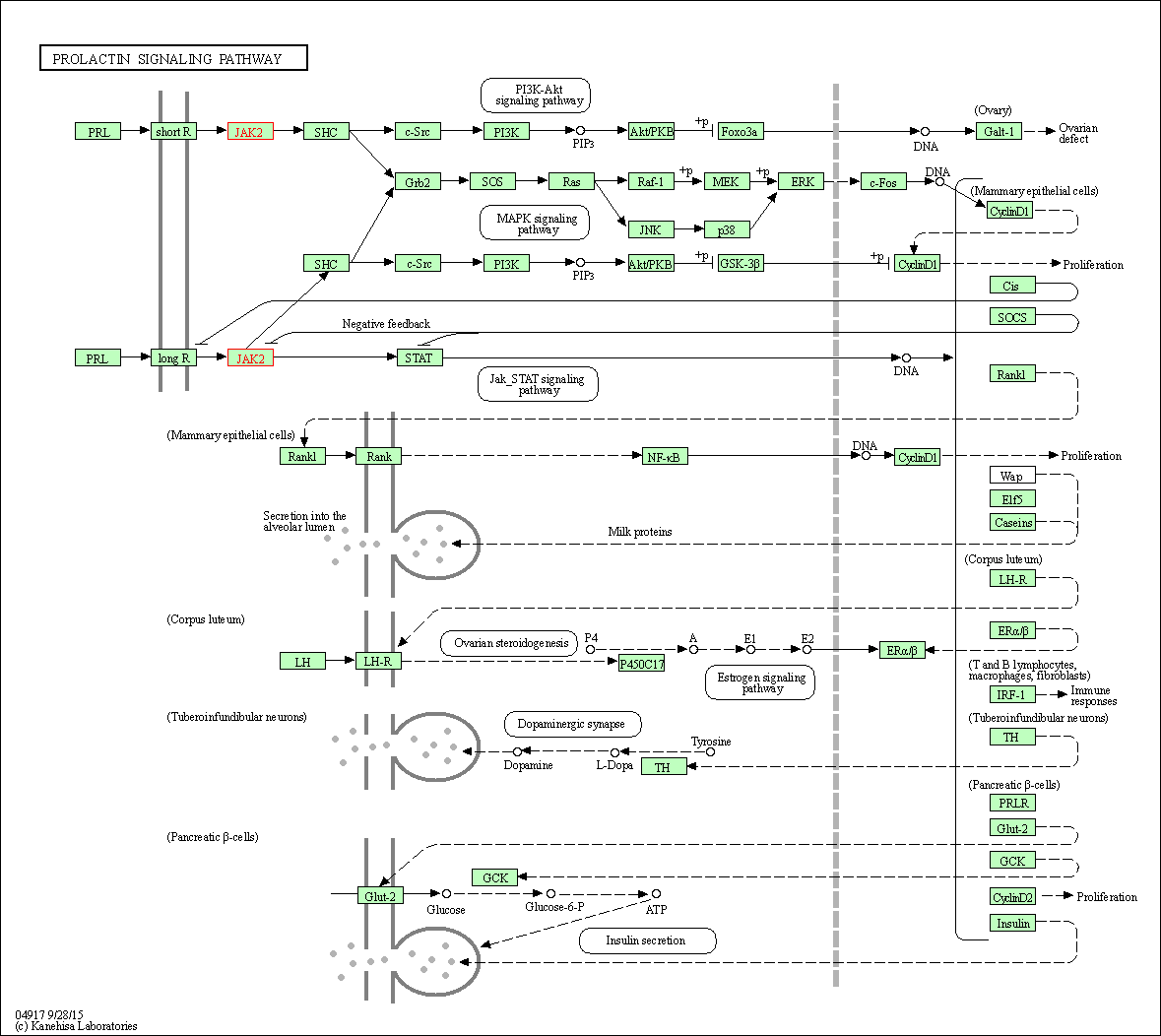
|
| Class: Organismal Systems => Endocrine system | Pathway Hierarchy | ||
| Adipocytokine signaling pathway | hsa04920 | Affiliated Target |

|
| Class: Organismal Systems => Endocrine system | Pathway Hierarchy | ||
| Growth hormone synthesis, secretion and action | hsa04935 | Affiliated Target |
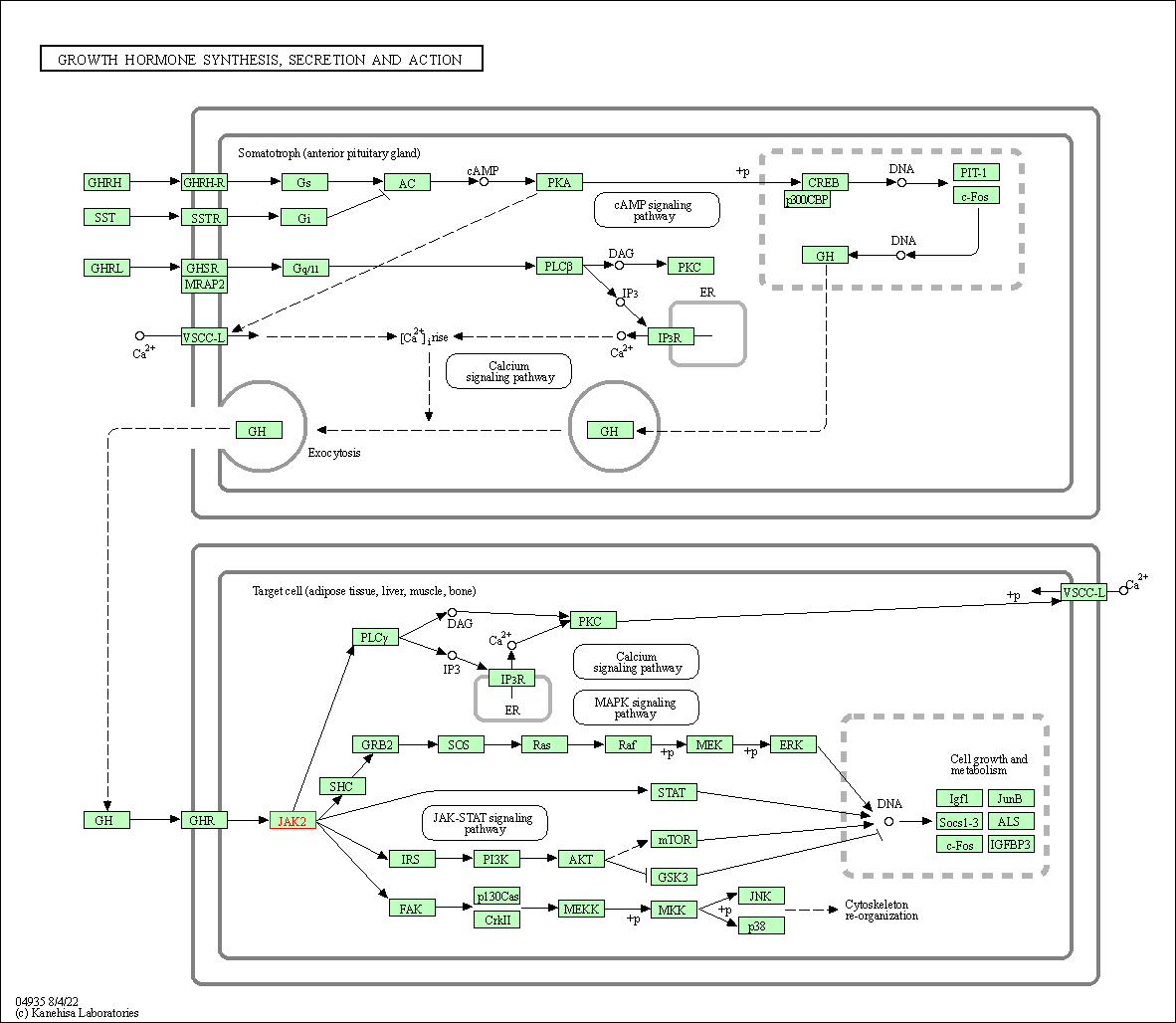
|
| Class: Organismal Systems => Endocrine system | Pathway Hierarchy | ||
| Click to Show/Hide the Information of Affiliated Human Pathways | |||
| Degree | 72 | Degree centrality | 7.74E-03 | Betweenness centrality | 3.56E-03 |
|---|---|---|---|---|---|
| Closeness centrality | 2.56E-01 | Radiality | 1.44E+01 | Clustering coefficient | 1.15E-01 |
| Neighborhood connectivity | 3.42E+01 | Topological coefficient | 4.25E-02 | Eccentricity | 11 |
| Download | Click to Download the Full PPI Network of This Target | ||||
| Chemical Structure based Activity Landscape of Target | Top |
|---|---|
| Drug Property Profile of Target | Top | |
|---|---|---|
| (1) Molecular Weight (mw) based Drug Clustering | (2) Octanol/Water Partition Coefficient (xlogp) based Drug Clustering | |
|
|
||
| (3) Hydrogen Bond Donor Count (hbonddonor) based Drug Clustering | (4) Hydrogen Bond Acceptor Count (hbondacc) based Drug Clustering | |
|
|
||
| (5) Rotatable Bond Count (rotbonds) based Drug Clustering | (6) Topological Polar Surface Area (polararea) based Drug Clustering | |
|
|
||
| "RO5" indicates the cutoff set by lipinski's rule of five; "D123AB" colored in GREEN denotes the no violation of any cutoff in lipinski's rule of five; "D123AB" colored in PURPLE refers to the violation of only one cutoff in lipinski's rule of five; "D123AB" colored in BLACK represents the violation of more than one cutoffs in lipinski's rule of five | ||
| Co-Targets | Top | |||||
|---|---|---|---|---|---|---|
| Co-Targets | ||||||
| Target Poor or Non Binders | Top | |||||
|---|---|---|---|---|---|---|
| Target Poor or Non Binders | ||||||
| Target Regulators | Top | |||||
|---|---|---|---|---|---|---|
| Target-regulating microRNAs | ||||||
| Target-interacting Proteins | ||||||
| Target Profiles in Patients | Top | |||||
|---|---|---|---|---|---|---|
| Target Expression Profile (TEP) | ||||||
| Drug Resistance Mutation (DRM) | ||||||
| Target-Related Models and Studies | Top | |||||
|---|---|---|---|---|---|---|
| Target Validation | ||||||
| References | Top | |||||
|---|---|---|---|---|---|---|
| REF 1 | 2011 FDA drug approvals. Nat Rev Drug Discov. 2012 Feb 1;11(2):91-4. | |||||
| REF 2 | URL: http://www.guidetopharmacology.org Nucleic Acids Res. 2015 Oct 12. pii: gkv1037. The IUPHAR/BPS Guide to PHARMACOLOGY in 2016: towards curated quantitative interactions between 1300 protein targets and 6000 ligands. (Ligand id: 5688). | |||||
| REF 3 | ClinicalTrials.gov (NCT02038036) Ruxolitinib Efficacy and Safety in Patients With HU Resistant or Intolerant Polycythemia Vera vs Best Available Therapy.. U.S. National Institutes of Health. | |||||
| REF 4 | Ruxolitinib versus standard therapy for the treatment of polycythemia vera. N Engl J Med. 2015 Jan 29;372(5):426-35. | |||||
| REF 5 | Drugs@FDA. U.S. Food and Drug Administration. U.S. Department of Health & Human Services. | |||||
| REF 6 | 2018 FDA drug approvals.Nat Rev Drug Discov. 2019 Feb;18(2):85-89. | |||||
| REF 7 | FDA Approved Drug Products from FDA Official Website. 2023. Application Number: 213871. | |||||
| REF 8 | Drugs@FDA. U.S. Food and Drug Administration. U.S. Department of Health Human Services. 2019 | |||||
| REF 9 | FDA Approved Drug Products from FDA Official Website. 2023. Application Number: 216873 | |||||
| REF 10 | Clinical pipeline report, company report or official report of the Pharmaceutical Research and Manufacturers of America (PhRMA) | |||||
| REF 11 | URL: http://www.guidetopharmacology.org Nucleic Acids Res. 2015 Oct 12. pii: gkv1037. The IUPHAR/BPS Guide to PHARMACOLOGY in 2016: towards curated quantitative interactions between 1300 protein targets and 6000 ligands. (Ligand id: 7971). | |||||
| REF 12 | Update on JAK2 Inhibitors in Myeloproliferative Neoplasm. Ther Adv Hematol. 2011 Apr;2(2):61-71. | |||||
| REF 13 | ClinicalTrials.gov (NCT03898479) Extension Study to Evaluate Safety and Efficacy of CTP-543 in Adults With Alopecia Areata. U.S. National Institutes of Health. | |||||
| REF 14 | ClinicalTrials.gov (NCT04150341) A Randomized, Double-blind, Placebo-controlled, 3-period Crossover Study to Evaluate the Effects of Repeated Doses of Inhaled TD-8236 and Impact on Airway Responses Following Allergen Challenge in Patients With Asthma. U.S.National Institutes of Health. | |||||
| REF 15 | Clinical pipeline report, company report or official report of Klus Pharma | |||||
| REF 16 | URL: http://www.guidetopharmacology.org Nucleic Acids Res. 2015 Oct 12. pii: gkv1037. The IUPHAR/BPS Guide to PHARMACOLOGY in 2016: towards curated quantitative interactions between 1300 protein targets and 6000 ligands. (Ligand id: 5933). | |||||
| REF 17 | The Janus kinases inhibitor AZD1480 attenuates growth of small cell lung cancers in vitro and in vivo. Clin Cancer Res. 2013 Dec 15;19(24):6777-86. | |||||
| REF 18 | URL: http://www.guidetopharmacology.org Nucleic Acids Res. 2015 Oct 12. pii: gkv1037. The IUPHAR/BPS Guide to PHARMACOLOGY in 2016: towards curated quantitative interactions between 1300 protein targets and 6000 ligands. (Ligand id: 7954). | |||||
| REF 19 | Characterization of BMS-911543, a functionally selective small-molecule inhibitor of JAK2. Leukemia. 2012 Feb;26(2):280-8. | |||||
| REF 20 | Clinical pipeline report, company report or official report of the Pharmaceutical Research and Manufacturers of America (PhRMA) | |||||
| REF 21 | Clinical pipeline report, company report or official report of the Pharmaceutical Research and Manufacturers of America (PhRMA) | |||||
| REF 22 | Clinical pipeline report, company report or official report of the Pharmaceutical Research and Manufacturers of America (PhRMA) | |||||
| REF 23 | URL: http://www.guidetopharmacology.org Nucleic Acids Res. 2015 Oct 12. pii: gkv1037. The IUPHAR/BPS Guide to PHARMACOLOGY in 2016: towards curated quantitative interactions between 1300 protein targets and 6000 ligands. (Ligand id: 8364). | |||||
| REF 24 | URL: http://www.guidetopharmacology.org Nucleic Acids Res. 2015 Oct 12. pii: gkv1037. The IUPHAR/BPS Guide to PHARMACOLOGY in 2016: towards curated quantitative interactions between 1300 protein targets and 6000 ligands. (Ligand id: 7909). | |||||
| REF 25 | ClinicalTrials.gov (NCT01594723) A Study of LY2784544 in Participants With Myeloproliferative Neoplasms. U.S. National Institutes of Health. | |||||
| REF 26 | LY2784544, a small molecule JAK2 inhibitor, induces apoptosis in inflammatory breast cancer spheres through targeting IL-6-JAK-STAT3 pathway. Cancer Research 07/2011; 71(8 Supplement):2820-2820. | |||||
| REF 27 | ClinicalTrials.gov (NCT01994382) A Phase 1/2a Open-Label, Multi-Dose, Multi-Center Escalation and Exploratory Study of Cerdulatinib (PRT062070) in Patients With Relapsed/Refractory Chronic Lymphocytic Leukemia (CLL)/Small Lymphocytic Lymphoma (SLL) or B-Cell or T-Cell Non-Hodgkin Lymphoma (NHL). U.S.National Institutes of Health. | |||||
| REF 28 | URL: http://www.guidetopharmacology.org Nucleic Acids Res. 2015 Oct 12. pii: gkv1037. The IUPHAR/BPS Guide to PHARMACOLOGY in 2016: towards curated quantitative interactions between 1300 protein targets and 6000 ligands. (Ligand id: 7839). | |||||
| REF 29 | Effect of NS-018, a selective JAK2V617F inhibitor, in a murine model of myelofibrosis. Blood Cancer J. 2014 Jan 10;4:e174. | |||||
| REF 30 | Inhaled JAK inhibitor GDC-0214 reduces exhaled nitric oxide in patients with mild asthma: A?randomized, controlled, proof-of-activity trial. J Allergy Clin Immunol. 2021 Sep;148(3):783-789. | |||||
| REF 31 | ClinicalTrials.gov (NCT05206604) A PHASE 1, RANDOMIZED, DOUBLE-BLIND, SPONSOR-OPEN, VEHICLE-CONTROLLED, FIRST-IN-HUMAN, MULTIPLE-DOSE STUDY, TO INVESTIGATE THE SAFETY, TOLERABILITY, AND PHARMACOKINETICS, OF TOPICALLY ADMINISTERED PF-07295324 AND PF-07259955, IN HEALTHY ADULT PARTICIPANTS. U.S.National Institutes of Health. | |||||
| REF 32 | ClinicalTrials.gov (NCT04769869) A Single-blind, Randomized, Placebo-controlled 3 Part Study in Healthy Volunteers and Patients With Mild Asthma to Investigate the Safety, Tolerability, and Pharmacokinetics of Inhaled AZD4604 Following Single and Multiple Ascending Doses and to Investigate the Anti-inflammatory Effect of Inhaled AZD4604. U.S.National Institutes of Health. | |||||
| REF 33 | ClinicalTrials.gov (NCT05006521) Phase 1 Randomized, Double-Blind, Placebo-Controlled Study to Evaluate the Safety, PK, and PD of Single Ascending Doses of KN-002 in Healthy Subjects and Multiple Ascending Doses of KN-002 in Subjects With Mild Asthma, Moderate-Severe Asthma and COPD. U.S.National Institutes of Health. | |||||
| REF 34 | ClinicalTrials.gov (NCT01287858) Study to Assess Safety, Tolerability, and Pharmacokinetics of Oral Doses for AC430 in Healthy Subjects. U.S. National Institutes of Health. | |||||
| REF 35 | Trusted, scientifically sound profiles of drug programs, clinical trials, safety reports, and company deals, written by scientists. Springer. 2015. Adis Insight (drug id 800032732) | |||||
| REF 36 | ClinicalTrials.gov (NCT01235871) A Single and Multiple-Dose Study of SB1578. U.S. National Institutes of Health. | |||||
| REF 37 | URL: http://www.guidetopharmacology.org Nucleic Acids Res. 2015 Oct 12. pii: gkv1037. The IUPHAR/BPS Guide to PHARMACOLOGY in 2016: towards curated quantitative interactions between 1300 protein targets and 6000 ligands. (Ligand id: 5916). | |||||
| REF 38 | Trusted, scientifically sound profiles of drug programs, clinical trials, safety reports, and company deals, written by scientists. Springer. 2015. Adis Insight (drug id 800006610) | |||||
| REF 39 | Emerging drugs for the therapy of primary and post essential thrombocythemia, post polycythemia vera myelofibrosis. Expert Opin Emerg Drugs. 2009 Sep;14(3):471-9. | |||||
| REF 40 | Emerging therapies for multiple myeloma. Expert Opin Emerg Drugs. 2009 Mar;14(1):99-127. | |||||
| REF 41 | The JAK2 inhibitor AZD1480 potently blocks Stat3 signaling and oncogenesis in solid tumors. Cancer Cell. 2009 Dec 8;16(6):487-97. | |||||
| REF 42 | Company report (Portola Pharmaceuticals) | |||||
| REF 43 | URL: http://www.guidetopharmacology.org Nucleic Acids Res. 2015 Oct 12. pii: gkv1037. The IUPHAR/BPS Guide to PHARMACOLOGY in 2016: towards curated quantitative interactions between 1300 protein targets and 6000 ligands. (Target id: 2048). | |||||
| REF 44 | Discovery and characterization of LY2784544, a small-molecule tyrosine kinase inhibitor of JAK2V617F. Blood Cancer J. 2013 Apr 12;3:e109. | |||||
| REF 45 | Selective JAK inhibitors in development for rheumatoid arthritis. Expert Opin Investig Drugs. 2014 Aug;23(8):1067-77. | |||||
| REF 46 | Comparison of mutated ABL1 and JAK2 as oncogenes and drug targets in myeloproliferative disorders. Leukemia. 2008 Jul;22(7):1320-34. | |||||
| REF 47 | SB1578, a novel inhibitor of JAK2, FLT3, and c-Fms for the treatment of rheumatoid arthritis. J Immunol. 2012 Oct 15;189(8):4123-34. | |||||
| REF 48 | Inhibitors of JAK-family kinases: an update on the patent literature 2013-2015, part 1.Expert Opin Ther Pat. 2017 Feb;27(2):127-143. | |||||
| REF 49 | Inhibitors of JAK-family kinases: an update on the patent literature 2013-2015, part 2.Expert Opin Ther Pat. 2017 Feb;27(2):145-161. | |||||
| REF 50 | A STAT inhibitor patent review: progress since 2011.Expert Opin Ther Pat. 2015;25(12):1397-421. | |||||
| REF 51 | Jak2 tyrosine kinase mediates oxidative stress-induced apoptosis in vascular smooth muscle cells. J Biol Chem. 2004 Aug 13;279(33):34547-52. | |||||
| REF 52 | The JAK2 inhibitor AG490 predominantly abrogates the growth of human B-precursor leukemic cells with 11q23 translocation or Philadelphia chromosome. Leukemia. 2001 Nov;15(11):1758-68. | |||||
| REF 53 | The Protein Data Bank. Nucleic Acids Res. 2000 Jan 1;28(1):235-42. | |||||
| REF 54 | Janus kinase 2 inhibitors. Synthesis and characterization of a novel polycyclic azaindole. J Med Chem. 2009 Dec 24;52(24):7938-41. | |||||
| REF 55 | Effects of the JAK2 inhibitor, AZ960, on Pim/BAD/BCL-xL survival signaling in the human JAK2 V617F cell line SET-2. J Biol Chem. 2008 Nov 21;283(47):32334-43. | |||||
| REF 56 | Photochemical preparation of a pyridone containing tetracycle: a Jak protein kinase inhibitor. Bioorg Med Chem Lett. 2002 Apr 22;12(8):1219-23. | |||||
| REF 57 | In silico identification and biochemical evaluation of novel inhibitors of NRH:quinone oxidoreductase 2 (NQO2). Bioorg Med Chem Lett. 2010 Dec 15;20(24):7331-6. | |||||
| REF 58 | A Non-ATP-Competitive Dual Inhibitor of JAK2 and BCR-ABL Kinases: Elucidation of a Novel Therapeutic Spectrum Based on Substrate Competitive Inhibition. Genes Cancer. 2010 Apr;1(4):331-45. | |||||
| REF 59 | In vitro and in vivo evaluation of 6-aminopyrazolyl-pyridine-3-carbonitriles as JAK2 kinase inhibitors. Bioorg Med Chem Lett. 2011 May 15;21(10):2958-61. | |||||
| REF 60 | The specificity of JAK3 kinase inhibitors. Blood. 2008 Feb 15;111(4):2155-7. | |||||
| REF 61 | Degradation of Janus kinases in CRLF2-rearranged acute lymphoblastic leukemia. Blood. 2021 Dec 9;138(23):2313-2326. | |||||
If You Find Any Error in Data or Bug in Web Service, Please Kindly Report It to Dr. Zhou and Dr. Zhang.

